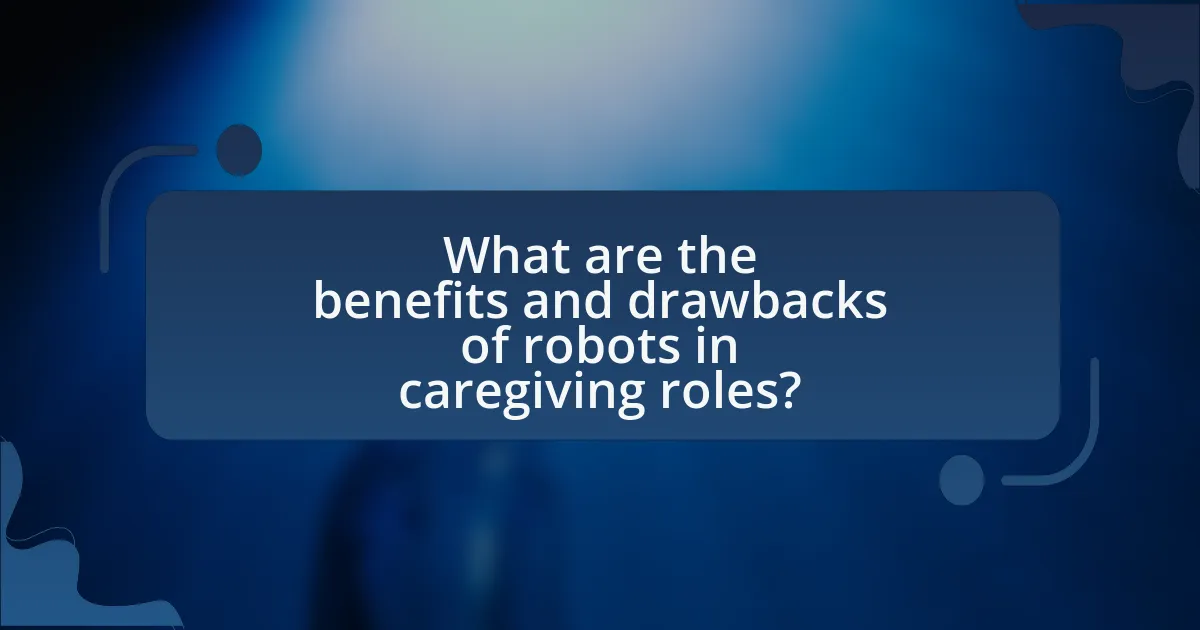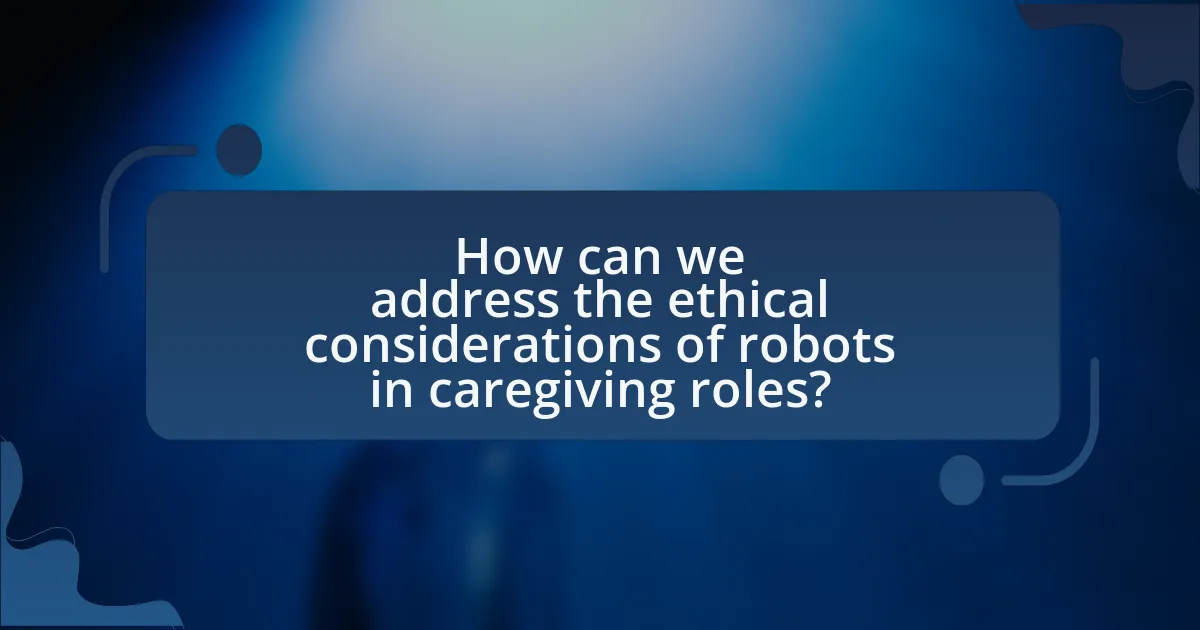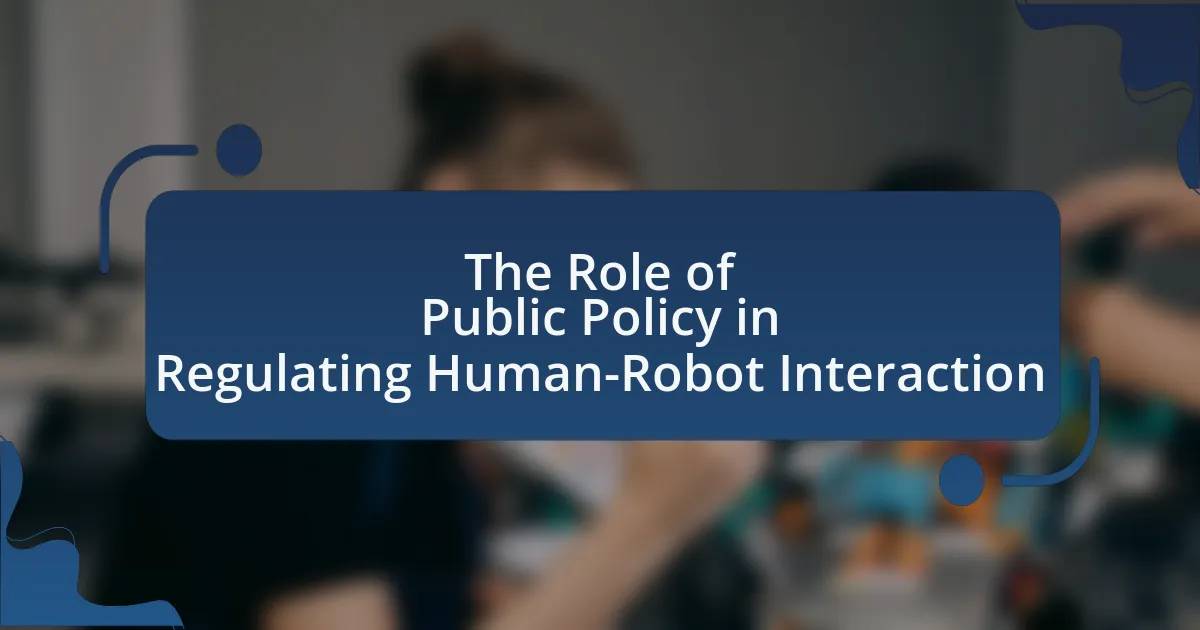The article examines the ethical implications of using robots in caregiving roles, focusing on concerns related to autonomy, privacy, and the quality of care. It discusses how robots can enhance caregiving efficiency and consistency while also highlighting the limitations in emotional support compared to human caregivers. Key ethical dilemmas, such as the potential for reduced human interaction and privacy risks, are explored alongside societal perceptions and cultural attitudes towards robotic assistance in caregiving. The article emphasizes the importance of ethical frameworks and guidelines to ensure responsible integration of robots in caregiving settings, addressing both the benefits and drawbacks of this technology.

What are the ethical implications of using robots in caregiving roles?
The ethical implications of using robots in caregiving roles include concerns about autonomy, privacy, and the quality of care provided. Robots may undermine the autonomy of patients by making decisions without human oversight, potentially leading to a lack of personalized care. Additionally, the use of robots raises privacy issues, as sensitive personal data may be collected and stored without adequate consent or security measures. Studies, such as those published in the Journal of Medical Ethics, highlight that while robots can enhance efficiency, they may also lead to emotional detachment and a decrease in human interaction, which is crucial for effective caregiving.
How do robots impact the quality of care provided to individuals?
Robots enhance the quality of care provided to individuals by improving efficiency, consistency, and accessibility of services. For instance, robotic systems can assist healthcare professionals by performing routine tasks such as medication dispensing and monitoring vital signs, which allows human caregivers to focus on more complex patient interactions. Research published in the Journal of Medical Internet Research indicates that robotic assistance can lead to a 30% increase in the time healthcare workers spend on direct patient care, thereby improving overall patient satisfaction and outcomes. Additionally, robots can provide companionship and support for individuals with mobility issues or cognitive impairments, which has been shown to reduce feelings of loneliness and depression, further enhancing the quality of care.
What specific caregiving tasks can robots perform effectively?
Robots can effectively perform specific caregiving tasks such as medication management, monitoring vital signs, assisting with mobility, and providing companionship. For instance, robots like the medication dispensing system can accurately deliver prescribed doses to patients, reducing the risk of human error. Additionally, robots equipped with sensors can monitor vital signs such as heart rate and blood pressure, alerting caregivers to any abnormalities. In terms of mobility assistance, robots can help individuals with physical disabilities navigate their environment safely. Furthermore, social robots can engage in conversations and provide emotional support, which has been shown to improve the mental well-being of elderly individuals. These capabilities demonstrate the practical applications of robots in caregiving, supported by studies indicating their effectiveness in enhancing patient care and safety.
How do robots compare to human caregivers in terms of emotional support?
Robots provide limited emotional support compared to human caregivers, primarily due to their inability to genuinely understand and respond to complex human emotions. Human caregivers can empathize, offer comfort, and build meaningful relationships, which are essential for emotional well-being. Research indicates that while robots can simulate certain supportive behaviors, such as companionship through programmed responses, they lack the emotional intelligence and nuanced understanding that humans possess. For instance, a study published in the journal “Social Robotics” found that human interactions significantly enhance emotional health, while robotic interactions often fall short in providing the same depth of emotional connection.
What ethical dilemmas arise from the use of robots in caregiving?
The ethical dilemmas arising from the use of robots in caregiving include issues of autonomy, privacy, and the quality of human interaction. Autonomy is challenged as robots may make decisions on behalf of patients, potentially undermining their independence. Privacy concerns emerge when robots collect and store sensitive personal data, raising questions about data security and consent. Additionally, the quality of human interaction may diminish, as reliance on robots could lead to emotional detachment and reduced empathy in caregiving, which are crucial for mental well-being. These dilemmas highlight the need for careful consideration of ethical frameworks in the integration of robots into caregiving roles.
How does the presence of robots affect the relationship between caregivers and patients?
The presence of robots in caregiving roles can both enhance and complicate the relationship between caregivers and patients. Robots can provide assistance with daily tasks, which may allow caregivers to focus more on emotional support and interaction, thereby improving the quality of care. For instance, a study published in the journal “Health Affairs” found that the use of robotic assistants in elder care settings led to increased patient satisfaction and reduced caregiver burnout. However, the introduction of robots can also create feelings of alienation or distrust among patients, particularly if they perceive robots as a replacement for human interaction. This dual impact highlights the need for careful integration of robotic technology in caregiving to ensure that it complements rather than undermines the human aspects of care.
What are the potential risks of relying on robots for caregiving?
Relying on robots for caregiving poses several potential risks, including reduced emotional connection, dependency on technology, and privacy concerns. The lack of human empathy in robotic interactions can lead to inadequate emotional support for individuals requiring care, as studies indicate that emotional bonds significantly enhance the quality of caregiving. Additionally, over-reliance on robotic systems may foster dependency, diminishing the ability of caregivers and recipients to engage in essential human interactions and problem-solving. Privacy risks also arise, as robots often collect sensitive personal data, which can be vulnerable to breaches or misuse, highlighting the need for stringent data protection measures.
What are the societal perceptions of robots in caregiving roles?
Societal perceptions of robots in caregiving roles are mixed, with both optimism and skepticism present. Many individuals view robots as beneficial tools that can enhance care efficiency and address labor shortages in healthcare, particularly as the global population ages. For instance, a study by the Pew Research Center in 2017 found that 72% of Americans believe robots will play a significant role in caregiving in the future. However, concerns about emotional connection, ethical implications, and the potential for job displacement also exist. A survey conducted by the University of California, Berkeley, revealed that 60% of respondents expressed discomfort with the idea of robots providing emotional support to the elderly, highlighting fears about the adequacy of robotic empathy compared to human caregivers. These contrasting views illustrate the complexity of societal attitudes toward robots in caregiving roles.
How do cultural attitudes influence the acceptance of robots in caregiving?
Cultural attitudes significantly influence the acceptance of robots in caregiving by shaping perceptions of technology and trust in automated systems. For instance, societies that prioritize collectivism and familial bonds may view robots as a threat to traditional caregiving roles, leading to resistance against their integration. Conversely, cultures that embrace technological advancement and individualism may be more open to utilizing robots for caregiving tasks. Research indicates that in countries like Japan, where there is a high acceptance of robots due to cultural familiarity with technology, robots are increasingly integrated into elder care, reflecting a positive attitude towards their use. In contrast, in cultures with strong beliefs in human-centric care, such as many Western nations, there is often skepticism regarding the emotional and ethical implications of robotic caregivers. This divergence in cultural attitudes directly impacts the level of acceptance and implementation of robots in caregiving roles.
What role does public trust play in the integration of robots in caregiving?
Public trust is essential for the successful integration of robots in caregiving, as it directly influences acceptance and usage. When individuals trust that robots will perform tasks safely, effectively, and ethically, they are more likely to embrace their presence in caregiving roles. Research indicates that high levels of public trust can lead to increased willingness to use robotic assistance, as seen in studies where trust in technology correlates with positive attitudes towards robotic caregivers. For instance, a survey conducted by the Pew Research Center found that 72% of respondents expressed concerns about robots in caregiving, highlighting the need for transparency and reliability to build trust. Thus, fostering public trust is crucial for overcoming skepticism and ensuring the effective deployment of robots in caregiving settings.
How can ethical frameworks guide the implementation of robots in caregiving?
Ethical frameworks can guide the implementation of robots in caregiving by establishing principles that prioritize human dignity, safety, and autonomy. These frameworks, such as utilitarianism and deontological ethics, help in assessing the potential benefits and harms of robotic assistance, ensuring that technology enhances rather than undermines the quality of care. For instance, the ethical principle of beneficence emphasizes the importance of promoting well-being, which can be operationalized through robots designed to assist with daily activities, thereby improving the lives of elderly or disabled individuals. Additionally, frameworks that stress informed consent ensure that caregivers and recipients understand the role of robots, fostering trust and transparency in caregiving relationships. Research by the IEEE Global Initiative on Ethics of Autonomous and Intelligent Systems highlights the necessity of ethical considerations in technology deployment, reinforcing that ethical guidelines are essential for responsible innovation in caregiving.
What principles should be considered when designing caregiving robots?
When designing caregiving robots, key principles include safety, user-centered design, ethical considerations, and adaptability. Safety ensures that robots do not harm users or themselves, which is critical in caregiving environments where vulnerable populations are involved. User-centered design focuses on creating interfaces and functionalities that are intuitive and accessible for both caregivers and recipients, enhancing usability and acceptance. Ethical considerations involve respecting privacy, autonomy, and dignity of users, ensuring that robots support rather than replace human interaction. Adaptability allows robots to respond to diverse needs and changing circumstances, making them effective in various caregiving scenarios. These principles are supported by research indicating that adherence to safety and ethical standards significantly improves the effectiveness and acceptance of caregiving robots in real-world applications.
How can stakeholders ensure ethical practices in robot-assisted caregiving?
Stakeholders can ensure ethical practices in robot-assisted caregiving by establishing clear guidelines and standards that prioritize patient dignity, safety, and autonomy. These guidelines should be informed by interdisciplinary collaboration among ethicists, healthcare professionals, and technologists to address the complexities of caregiving. For instance, the IEEE Global Initiative on Ethics of Autonomous and Intelligent Systems provides a framework that emphasizes transparency, accountability, and the importance of human oversight in robotic systems. By adhering to such established ethical frameworks, stakeholders can mitigate risks associated with robot-assisted caregiving and promote trust among patients and caregivers.

What are the benefits and drawbacks of robots in caregiving roles?
Robots in caregiving roles offer significant benefits and drawbacks. The primary benefit is their ability to provide consistent and reliable assistance, which can enhance the quality of care for individuals, particularly the elderly or those with disabilities. For instance, robots can assist with daily tasks such as medication reminders, mobility support, and companionship, which can alleviate the burden on human caregivers and improve patient outcomes. A study published in the journal “Health Affairs” found that robotic assistance can reduce caregiver stress and increase the efficiency of care delivery.
Conversely, the drawbacks include the potential for reduced human interaction, which is crucial for emotional support and mental well-being. The reliance on robots may lead to feelings of isolation among patients, as they may prefer human contact over robotic assistance. Additionally, ethical concerns arise regarding privacy and the potential for job displacement among human caregivers. Research from the “Journal of Medical Ethics” highlights that while robots can enhance care, they cannot replace the empathy and understanding that human caregivers provide, which is essential for holistic care.
What advantages do robots offer in caregiving settings?
Robots offer several advantages in caregiving settings, including enhanced efficiency, consistent monitoring, and reduced caregiver burnout. These machines can perform repetitive tasks, such as medication reminders and mobility assistance, allowing human caregivers to focus on more complex emotional and social interactions. Studies indicate that robots can provide continuous monitoring of patients’ health metrics, which can lead to timely interventions and improved health outcomes. Furthermore, the use of robots can alleviate the physical and emotional strain on human caregivers, thereby reducing turnover rates and improving job satisfaction.
How can robots enhance efficiency in caregiving tasks?
Robots can enhance efficiency in caregiving tasks by automating routine activities, thereby allowing human caregivers to focus on more complex and personalized care. For instance, robots can assist with medication management, monitoring vital signs, and providing companionship, which reduces the workload on human staff. A study published in the Journal of Medical Internet Research found that robotic systems can improve task completion times by up to 30%, demonstrating their effectiveness in streamlining caregiving processes. This efficiency not only optimizes resource allocation but also enhances the overall quality of care provided to patients.
What cost savings can be achieved through the use of robots in caregiving?
The use of robots in caregiving can achieve significant cost savings, primarily by reducing labor costs and increasing efficiency. For instance, robots can perform routine tasks such as medication management and monitoring vital signs, which allows human caregivers to focus on more complex care needs. A study by the International Federation of Robotics indicates that implementing robotic systems in healthcare can reduce operational costs by up to 30%. Additionally, robots can work continuously without breaks, leading to increased productivity and lower staffing requirements, which further contributes to overall cost reductions in caregiving settings.
What challenges do robots face in caregiving environments?
Robots face several challenges in caregiving environments, primarily related to emotional intelligence, adaptability, and physical interaction. Emotional intelligence is crucial for understanding and responding to human emotions, which robots currently struggle with, limiting their effectiveness in providing empathetic care. Adaptability is another challenge, as caregiving situations often require quick adjustments to unexpected changes in patient behavior or health status, something robots find difficult due to their programmed nature. Additionally, physical interaction poses challenges; robots must navigate complex environments safely and effectively, which can be hindered by their mechanical design and limitations in mobility. These challenges highlight the need for advancements in robotics to enhance their role in caregiving.
How do technical limitations affect the performance of caregiving robots?
Technical limitations significantly hinder the performance of caregiving robots by restricting their ability to effectively interact with and respond to human needs. For instance, limitations in sensory perception, such as inadequate vision or hearing capabilities, prevent robots from accurately assessing the environment or recognizing emotional cues from patients. Additionally, restricted processing power can lead to slow decision-making, which is critical in caregiving scenarios that require immediate responses. Research indicates that robots with limited mobility and dexterity struggle to perform essential tasks, such as lifting or assisting individuals with mobility challenges, thereby reducing their overall effectiveness in caregiving roles. These technical shortcomings ultimately compromise the quality of care provided, highlighting the need for ongoing advancements in robotic technology to enhance their functionality in sensitive caregiving environments.
What are the concerns regarding privacy and data security with caregiving robots?
Concerns regarding privacy and data security with caregiving robots primarily involve the potential for unauthorized access to sensitive personal information. Caregiving robots often collect and process data related to health, daily activities, and personal preferences of individuals, which can be vulnerable to breaches. For instance, a study by the University of California, Berkeley, highlighted that data transmitted by connected devices, including caregiving robots, can be intercepted if not properly encrypted, leading to privacy violations. Additionally, the lack of stringent regulations governing data protection in the robotics sector raises further risks, as companies may not prioritize user privacy. These factors underscore the critical need for robust security measures and ethical guidelines in the deployment of caregiving robots.
What future developments can we expect in robot-assisted caregiving?
Future developments in robot-assisted caregiving will likely include enhanced artificial intelligence capabilities, improved emotional recognition, and greater integration with smart home technologies. These advancements will enable robots to provide more personalized care, respond to emotional cues, and assist with daily living activities more effectively. For instance, research indicates that AI-driven robots can learn from interactions to better understand individual preferences and needs, thereby improving the quality of care provided. Additionally, the integration of robots with IoT devices will facilitate seamless communication and coordination among caregivers, patients, and healthcare systems, leading to more efficient caregiving processes.
How might advancements in AI influence the capabilities of caregiving robots?
Advancements in AI will significantly enhance the capabilities of caregiving robots by enabling them to perform complex tasks, understand human emotions, and adapt to individual needs. For instance, improved machine learning algorithms allow robots to analyze vast amounts of data from user interactions, leading to personalized care plans that cater to specific health conditions or preferences. Additionally, advancements in natural language processing enable robots to communicate more effectively with patients, fostering better emotional connections and understanding. Research indicates that robots equipped with advanced AI can assist in monitoring vital signs and alerting caregivers to potential health issues, thereby improving patient outcomes and safety.
What trends are emerging in the design and functionality of caregiving robots?
Emerging trends in the design and functionality of caregiving robots include increased personalization, enhanced emotional intelligence, and improved mobility. Personalization allows robots to adapt to individual user needs, utilizing machine learning algorithms to tailor interactions and care routines. Enhanced emotional intelligence enables robots to recognize and respond to human emotions, fostering better companionship and support for users. Improved mobility features, such as advanced navigation systems and obstacle avoidance, allow caregiving robots to assist users more effectively in various environments. These trends reflect a growing emphasis on creating robots that not only perform tasks but also engage meaningfully with those they assist, addressing both practical and emotional aspects of caregiving.

How can we address the ethical considerations of robots in caregiving roles?
To address the ethical considerations of robots in caregiving roles, it is essential to establish clear guidelines that prioritize human dignity, autonomy, and safety. These guidelines should include transparency in robot capabilities and limitations, ensuring that caregivers and patients understand the role of robots in care. Additionally, ethical frameworks must be developed to govern decision-making processes, particularly in sensitive situations where human emotions and ethical dilemmas arise. Research indicates that involving stakeholders, including healthcare professionals, ethicists, and patients, in the design and implementation of robotic systems can enhance ethical compliance and acceptance. For instance, a study published in the journal “AI & Society” by authors such as Sharkey and Sharkey emphasizes the importance of human oversight in robotic caregiving to mitigate risks associated with autonomy and decision-making.
What best practices should be adopted for ethical robot integration in caregiving?
Best practices for ethical robot integration in caregiving include ensuring transparency in robot functionalities, prioritizing user consent, and maintaining data privacy. Transparency allows caregivers and patients to understand the robot’s capabilities and limitations, fostering trust. Prioritizing user consent ensures that individuals are informed and agree to the use of robots in their care, aligning with ethical standards of autonomy. Maintaining data privacy protects sensitive information, as studies indicate that breaches can lead to significant emotional distress for patients. Implementing these practices can enhance the ethical deployment of robots in caregiving settings.
How can training programs for caregivers include robot interaction guidelines?
Training programs for caregivers can include robot interaction guidelines by integrating specific modules that focus on the ethical and practical aspects of using robots in caregiving. These modules should cover topics such as understanding robot capabilities, communication techniques, and the importance of maintaining human empathy while interacting with robotic systems. Research indicates that effective training enhances caregivers’ confidence and competence in using technology, which is crucial as robots become more prevalent in caregiving settings. For instance, a study by Shibata et al. (2018) published in the journal “Robotics and Autonomous Systems” highlights that structured training improves caregivers’ ability to interact with robots, leading to better care outcomes for patients.
What role do policymakers play in regulating the use of robots in caregiving?
Policymakers play a crucial role in regulating the use of robots in caregiving by establishing guidelines and standards that ensure safety, ethical use, and effectiveness. They create frameworks that address issues such as data privacy, accountability, and the quality of care provided by robotic systems. For instance, the European Union has proposed regulations that focus on the ethical implications of AI in healthcare, emphasizing the need for transparency and human oversight in robotic caregiving. These regulations aim to protect vulnerable populations while promoting innovation in caregiving technologies.
What resources are available for understanding the ethical implications of caregiving robots?
Resources available for understanding the ethical implications of caregiving robots include academic journals, books, and online platforms dedicated to robotics and ethics. Notable academic journals such as “AI & Society” and “Robotics and Autonomous Systems” publish peer-reviewed articles that explore ethical concerns related to caregiving robots. Books like “Robot Ethics 2.0: From Autonomous Cars to Artificial Intelligence” by Patrick Lin, Keith Abney, and Ryan Jenkins provide comprehensive insights into the ethical frameworks applicable to robotics. Additionally, organizations such as the IEEE Global Initiative on Ethics of Autonomous and Intelligent Systems offer guidelines and reports that address ethical considerations in robotics. These resources collectively contribute to a deeper understanding of the ethical landscape surrounding caregiving robots.
Where can caregivers find guidelines on ethical robot use?
Caregivers can find guidelines on ethical robot use through organizations such as the IEEE Global Initiative on Ethics of Autonomous and Intelligent Systems, which provides comprehensive resources and frameworks. Additionally, the World Health Organization offers ethical guidelines specifically addressing the integration of robotics in healthcare settings. These sources are recognized for their authoritative stance on ethical considerations in technology, ensuring caregivers have access to well-researched and validated information.
What organizations focus on the ethics of robotics in healthcare?
Organizations that focus on the ethics of robotics in healthcare include the Institute of Electrical and Electronics Engineers (IEEE), which has established the IEEE Global Initiative on Ethics of Autonomous and Intelligent Systems. This initiative aims to ensure that technology is aligned with human values and ethical considerations. Another key organization is the World Health Organization (WHO), which addresses ethical issues related to health technologies, including robotics. Additionally, the American Medical Association (AMA) provides guidelines and ethical frameworks for the integration of robotics in medical practice. These organizations contribute to the discourse on ethical standards and practices in the deployment of robotics within healthcare settings.
What practical steps can caregivers take to navigate the ethical landscape of robot use?
Caregivers can navigate the ethical landscape of robot use by establishing clear guidelines for interaction, ensuring informed consent, and prioritizing patient autonomy. Establishing guidelines helps caregivers define acceptable robot behaviors and interactions, which can mitigate ethical dilemmas. Informed consent involves educating patients and their families about the capabilities and limitations of robots, fostering transparency and trust. Prioritizing patient autonomy ensures that individuals retain control over their care decisions, aligning robot use with their preferences and values. These steps are supported by ethical frameworks in healthcare that emphasize respect for persons and beneficence, ensuring that technology enhances rather than undermines patient care.





